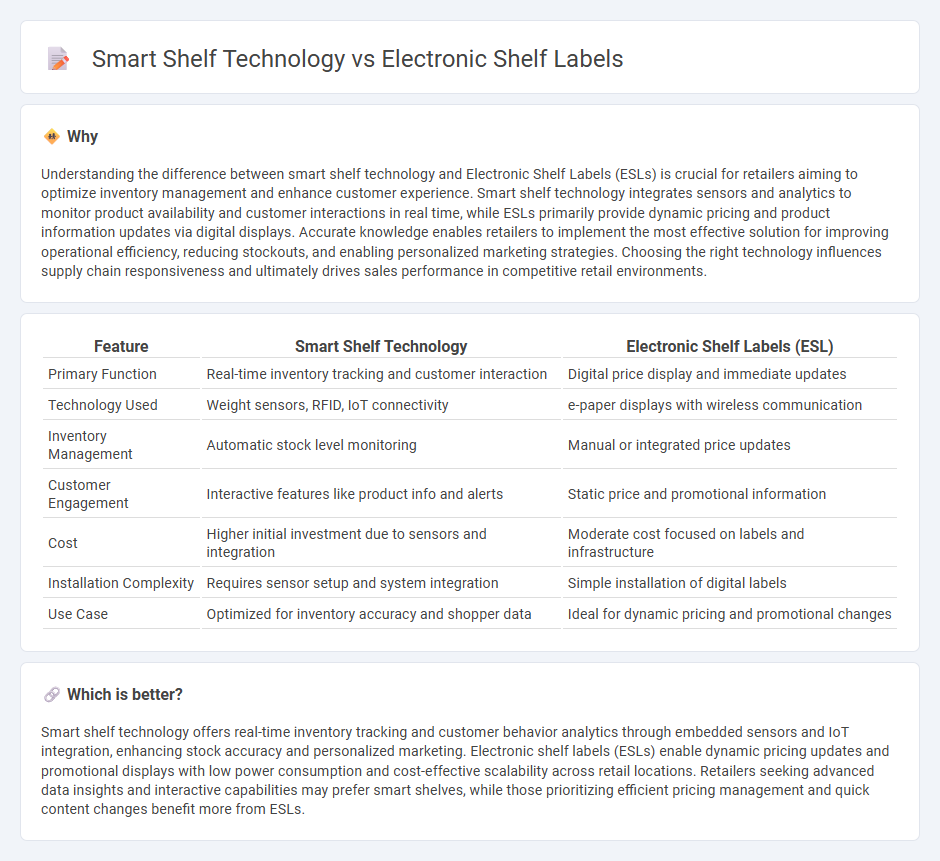
Smart shelf technology enhances inventory management by using sensors to monitor stock levels and customer interactions in real-time, optimizing product placement and reducing out-of-stock issues. Electronic shelf labels (ESLs) provide dynamic pricing and product information updates through digital displays, enabling quick price changes and improved accuracy while reducing labor costs. Explore the differences between smart shelves and ESLs to discover which technology best fits modern retail needs.
Why it is important
Understanding the difference between smart shelf technology and Electronic Shelf Labels (ESLs) is crucial for retailers aiming to optimize inventory management and enhance customer experience. Smart shelf technology integrates sensors and analytics to monitor product availability and customer interactions in real time, while ESLs primarily provide dynamic pricing and product information updates via digital displays. Accurate knowledge enables retailers to implement the most effective solution for improving operational efficiency, reducing stockouts, and enabling personalized marketing strategies. Choosing the right technology influences supply chain responsiveness and ultimately drives sales performance in competitive retail environments.
Comparison Table
| Feature | Smart Shelf Technology | Electronic Shelf Labels (ESL) |
|---|---|---|
| Primary Function | Real-time inventory tracking and customer interaction | Digital price display and immediate updates |
| Technology Used | Weight sensors, RFID, IoT connectivity | e-paper displays with wireless communication |
| Inventory Management | Automatic stock level monitoring | Manual or integrated price updates |
| Customer Engagement | Interactive features like product info and alerts | Static price and promotional information |
| Cost | Higher initial investment due to sensors and integration | Moderate cost focused on labels and infrastructure |
| Installation Complexity | Requires sensor setup and system integration | Simple installation of digital labels |
| Use Case | Optimized for inventory accuracy and shopper data | Ideal for dynamic pricing and promotional changes |
Which is better?
Smart shelf technology offers real-time inventory tracking and customer behavior analytics through embedded sensors and IoT integration, enhancing stock accuracy and personalized marketing. Electronic shelf labels (ESLs) enable dynamic pricing updates and promotional displays with low power consumption and cost-effective scalability across retail locations. Retailers seeking advanced data insights and interactive capabilities may prefer smart shelves, while those prioritizing efficient pricing management and quick content changes benefit more from ESLs.
Connection
Smart shelf technology integrates Electronic Shelf Labels (ESLs) to provide real-time pricing and inventory updates, enhancing retail management efficiency. These ESLs use digital displays connected to centralized systems, enabling dynamic pricing adjustments and reducing manual labor. The synergy between smart shelves and ESLs improves customer experience by ensuring accurate product information and availability at all times.
Key Terms
Dynamic Pricing
Electronic shelf labels (ESLs) provide real-time price updates through digital displays, allowing retailers to implement dynamic pricing strategies efficiently. Smart shelf technology integrates sensors and AI to monitor inventory levels and customer behavior, enabling more precise and automated price adjustments. Explore how combining ESLs with smart shelves can optimize pricing strategies and enhance retail profitability.
Inventory Management
Electronic shelf labels (ESLs) enhance inventory management through real-time price updates and product information synchronization, reducing manual errors and improving shelf accuracy. Smart shelf technology incorporates weight sensors and RFID, enabling automatic stock level monitoring and alerting staff to replenishment needs instantly. Explore how integrating ESLs and smart shelves can revolutionize your inventory control efficiency.
Real-time Data Integration
Electronic shelf labels (ESLs) provide dynamic pricing and product information updates through wireless communication, enhancing shelf management efficiency. Smart shelf technology integrates sensors and IoT devices to offer real-time inventory tracking, customer interaction data, and automated restocking alerts. Explore how combining ESLs with smart shelf solutions can optimize retail operations and improve customer experience.
Source and External Links
Global Leader for Electronic Shelf Labels | SESimagotag - Vusion - Offers high-quality electronic shelf labels for transforming physical stores into digital assets, enhancing agility and accuracy in pricing operations.
Electronic Shelf Label - Wikipedia - An electronic system used by retailers to display product pricing on shelves, allowing for automatic updates via a central computer server.
Pricer | The World's Most Reliable Electronic Shelf Labels (ESL) - Provides electronic shelf labeling solutions that save time with automatic price updates, enhancing retail efficiency.
 dowidth.com
dowidth.com